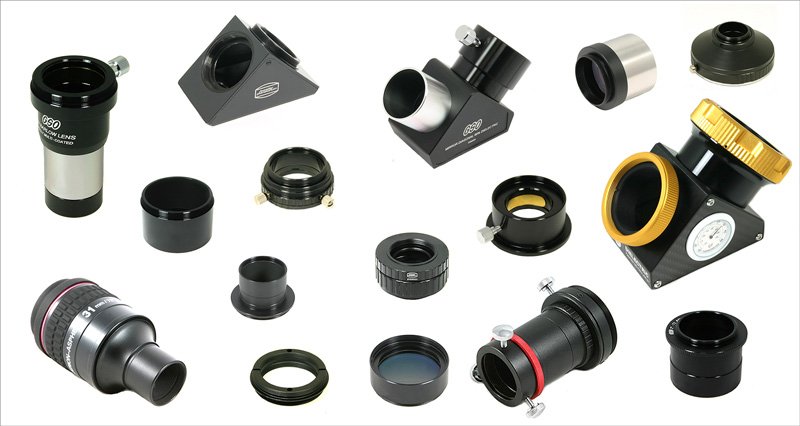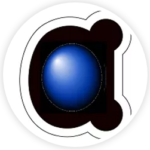Astronomy Threads Explained
Astronomy Threads Explained
Authors: Manish Panjwani and Brian Ventrudo Published: September 15, 2018 Last Revised: May 24, 2021
Figure 1 – An array of threaded optical components and adapters common in amateur astronomy. Image credit: Sergio Castillo/Agena AstroProducts.
Try Adsterra Earnings, it’s 100% Authentic to make money more and more.

1. Overview
Whether dealing with telescopes, eyepieces, filters, or focusers, nearly every amateur astronomer is bound to come across a large and sometimes confusing array of machined threads. Sorting out which type of thread is which, and which component fits into another, can make it difficult to find and order the right parts and make sure they all fit together.
To avoid such frustrations, it helps to understand the most common thread types found in astronomy equipment. Such information exists in bits and pieces in catalogs and on websites, but it’s hard to find a single good ‘primer’ that explains astronomy threads. This guide solves that problem. It explains everything you need to know about the configuration of astronomy threads to help you make informed buying decisions as you acquire new equipment or make the most of what you already have. If there’s one article or guide to read on the Agena AstroProducts website, this is it. It may save you a lot of time and headaches over the long run.
If you’re in a hurry, the next section explains how threads are specified, and it summarizes the most common types of threads used in eyepieces, filters, telescopes, cameras, and focusers. It will help you get oriented, and it may answer many common questions about thread configurations. However, we encourage you to read more of the details in later sections because they reveal a great deal of useful detail obtained over many years of experience. Once you learn more about threads, you may find them more interesting than you thought!
2. Astronomy Threads – The Essentials
There are two configurations of machined threads used in astronomy: UNC and Metric. UNC, which stands for ‘Unified Thread Coarse’, uses British Imperial units (usually inches) to specify the thread, while Metric threads are specified in millimeters.
Each thread has two main specifications: the diameter and the thread pitch (for metric) or thread count (for UNC). Thread sizes may be written as AxB, which is more common for metric threads, or as A-B, which is more common for UNC threads. A is the nominal thread diameter and B is the thread count or pitch.
For example,
- A UNC ¼”-20 thread has a nominal thread diameter of ¼” and a thread count of 20 threads per inch.
- A metric M4x0.7 thread has a nominal thread diameter of 4mm and a thread pitch of 0.7mm, which is the distance between each thread.
Each type of thread also comes in a male and female configuration, also commonly known as external and internal threads respectively. Inside the barrel of most 1.25″ eyepieces, for example, are female M28.5×0.6 threads. Color filter or light-pollution filters designed for 1.25″ eyepieces have cells with male M28.5×0.6 threads that mate with the threadsinsidethe eyepiece barrel.
Section 3 has more details and specifications for threads that will help you better understand UNC and metric thread configurations.
While there are dozens of threads commonly used in astronomy, from small M3 threads used on thumbscrews to large M117 threads used for large telescope focusers, most astronomers commonly encounter about a dozen thread types. Table 1 summarizes the configuration and application of the most common threads. Later sections will go into more detail about these and other threads used in amateur astronomy.
Table 1 – The most common threads used in amateur astronomical equipment, in order from smallest to largest thread diameter.
| Common Thread Name | Technical Specification | Comments |
|---|---|---|
| Webcam Thread | M12x0.5 | Found on webcams used in the early days of planetary imaging. Officially called an ‘S’ thread. |
| Video Thread (or C or CS Thread) | 1″-32 | Found in security and video cameras with a C or CS mount. C-mount and CS-mount lenses mount 17.5mm and 12.5mm in front of the sensor, respectively. |
| 1.25″ Eyepiece/Filter Thread | M28.5×0.6 | Very common in astronomy on barrels of 1.25″ eyepieces and 1.25″ filters. While 1.25″=31.7mm, the actual thread diameter is 28.5mm. |
| ETX/NexStar/NX4 Thread | 1.375″-24 | Found on Meade ETX telescopes from 90mm to 125mm in aperture, on Celestron Nexstar 4SE telescope, on some Celestron C90 spotting scopes, and a few other small Maksutov-Cassegrain telescopes. |
| T/T2/”42mm T” Thread | M42x0.75 | Very common in photography and astronomy. The “T thread” is identical to the T2 thread from Baader. Not the same as Pentax/screw/M42 thread, which is M42x1.0. |
| Maksutov Thread | M44.5×1.0 | Found on some intermediate-sized Maksutov telescopes sold by Orion, Sky-Watcher, and others. No after-market accessories available for this thread size, so users often convert to a larger 2″ SCT thread. Not a standard thread on all Maksutov telescopes. |
| Wide ‘T Thread’ or ’48mm T Thread’ | M48x0.75 | New, larger alternative to the “T/T2” thread. Usedwith larger-chip astronomy cameras to reduce vignetting. Also found onsome drawtubes, reducers, flatteners, off-axis guiders. Caution: “Wide” doesn’t always mean 48mm. See section 4.2.4. |
| 2″ Filter Thread or M48 Thread | M48x0.75 | Very common in astronomy on barrels of 2″ eyepieces and 2″ filters. While 2″=50.8mm, the actual thread diameter is 48mm. |
| 2″ (Small) SCT Thread | 2″-24 | Very common in astronomy on 5″ – 10″ SCTs from Meade and Celestron (except for the 9.25″ Edge HD OTA). Found on the rear cell of the SCT and on focal reducers and adapters. Also found on a few larger Mak scopes. |
| 3.25″/3.28″ (Large) SCT Thread | 3.25″-16 or 3.28″-16 | Meade SCTs of 12″ and greater aperture use 3.25″-16 threads. Celestron 9.25″ Edge HD OTA and all other SCTs of 11″ and greater aperture use 3.28″-16 threads on the rear cell and for accessories |
3. Astronomy Threads – A Deeper Dive
3.1 Thread Specifications
From an engineering point of view, there are many specifications that go into designing and manufacturing a thread. For astronomy end users, however, the key specifications are as follows:
- Gender: Male (external) threads are on the outside, while female (internal) threads are on the inside
- Major diameter (M1): For male threads, the maximum diameter of the screw thread measured at the outer edge (the crest) of a male thread
- Minor diameter (M2): For female threads, the inside diameter of the thread. In general, M1 is slightly larger than M2
- Thread pitch: The distance between the threads (a common specification for metric threads)
- Thread Count: The number of complete threads per unit length, usually per inch (a common specification for UNC threads)
- Thread undercut: A narrow unthreaded portion on a bolt, screw, or adapter before the thread starts
- Thread length: The length of the thread including the undercut
The drawing in Figure 2 below shows the definition of these specifications.

Figure 2 – The key specifications of male and female threads.
The specified dimensions of a thread are nominal, and they also include a manufacturing tolerance. Nominal means that the stated value may not correspond exactly to the true value. For example, a male M4 thread that has a nominal diameter of 4mm in fact has a true diameterthat can be between 3.838mm and 3.978mm.
3.2 International Thread Standards
There are several international standards for specifying threads. However, most astronomy threads are either ISO Metric or UN.
ISO Metric threads have dimensions specified in millimeters. This standard is common throughout the world, though it is less common in the U.S. Astronomy components manufactured outside the U.S. usually use this standard. An example of an ISO Metric thread specification is M42x0.75, which means a thread with a nominal major diameter of 42mm and a thread pitch of 0.75mm.
The UN (Unified Inch Thread) standard was developed by the U.S., Canada, and Great Britain after the Second World War. It replaced the American National Standards thread specifications. Some still refer to UN threads incorrectly as American threads. The threads are specified in inches. So, for example, a 3/8″-16 bolt has a nominal major diameter of 3/8″ and a thread pitch of 16 TPI (threads per inch). This standard is common in the U.S. and a few other countries. Astronomy equipment made in the U.S. often uses this standard. This standard also specifies coarse(UNC) and fine(UNF) threads. All astronomy/photo accessory threads – even though far finer than typical plumbing or industrial threads you may be familiar with – are still considered “coarse.”
4. Common Astronomy Threads
Table 1 above summarizes the most commonly used threads in amateur astronomy in order of size from smallest to largest. This section discusses these threads in more detail by their most common application, that is, in which type of equipment you might most often find these threads.
4.1 Eyepieces and Filters
4.1.1 Eyepiece/Filter Thread – 1.25″ (M28.5×0.6)
Nearly every amateur astronomer owns at least one 1.25″ eyepiece. The barrel of that eyepiece almost certainly is threaded to accept a threaded filter cell. While 1.25″ works out to 31.7mm, the actual thread has a nominal diameter of 28.5mm and a pitch of 0.6mm. When you choose a filter for a 1.25″ eyepiece, you will almost certainly find it has a male M28.5×0.6 thread.
A few manufacturers sometimes use a 1.25″ filter thread with different specifications. Orion filters are notorious for incompatibility issues in the US. Vernonscope, which makes Brandon eyepieces, uses a XX”-32 thread for their filters and eyepieces, and offers an adapter to thread the more common M28.5×0.6 filters onto Brandon eyepieces.
4.1.2 Eyepiece/Filter Thread 2″ (M48x0.75)
As with 1.25″ eyepieces, most 2″ eyepieces have barrels threaded to accept filters mounted in a cell. The diameter of 2″ works out to 50.8mm, but the actual thread has a nominal diameter of 48mm. In North America, many simply refer to this M48x0.75 thread as a “2-inch thread”. Europeans, however, take a “2-inch thread” to mean the 2″-24 thread used on the visual back of 5″ to 10″ Schmidt-Cassegrain telescopes by Celestron and Meade (see section 4.3.3 below). To avoid confusion, the M48x0.75 thread on eyepiece barrels and filters should be called a “2-inch filter thread”or “M48 filter thread.”
Unfortunately, there is less standardization on the thread pitch for 2″ eyepieces and filters. While the vast majority of astronomy manufacturers have now settled on a 0.75mm pitch, a few (most notably, Orion) use a 0.6mm thread pitch.
Baader Planetarium of Germany uses a slightly different thread pitch (which they do not specify, but which is a little less than 0.75mm) for their M48-threaded products. This was selected based on their measurements of hundreds of other M48 threaded accessories on the market, and which they believed would therefore increase the chances of their products being compatible with the largest number of non-Baader items. As a result, there is always the odd chance of some M48-threaded items not working well together.

Figure 3 – A Celestron UHC filter with a 2″ eyepiece thread (M48x0.75) – female on one side and male on the other. Image credit: Celestron
4.2 Cameras and Imaging Accessories
4.2.1 Webcam Thread (M12x0.5)
A webcam thread is officially called an “S thread,” but few in astronomy use this term. This M12x0.5 thread is found on webcams and a few other small cameras, and it was common when electronic imaging began and webcams were popular with planetary and lunar imagers. However, in the past few years, the use of webcams has waned as dedicated astronomy cameras have become smaller, lighter, better, and cheaper. These newer cameras used larger threads.
4.2.2 Video Thread (1″-32UNC)
These threads are commonly found in security and many video cameras and lenses. They are also called “C threads” or “CS threads”. C-mount lenses are made to mount 17.5mm in front of the image sensor, while CS-mount lenses are made to mount 12.5mm in front of the image sensor. The thread specification for C and CS is the same. The only difference is that a CS thread is 5mm shorter than a C mountthread. In astronomy, this thread is frequently found on smaller cameras or adapters included with these cameras.
4.2.3 T/T2 Thread or 42mm T-Thread (M42x0.75)
The photographic T-mount was introduced by Tamron (then known as Taisei) in the 1950s as a standard for camera lenses. The thread on the mount is called a T thread. This standard M42x0.75 thread has been very common in astronomy and astrophotography for decades on astronomy cameras, reducers, flatteners, flip mirrors, off-axis guiders, filter wheels and so forth.
The T-thread should not be confused with a “Pentax” or “Screw” or “M42” thread used in photography. This thread is M42x1.0, which is the same diameter as a T-thread but with a different thread pitch.
For all intents and purposes, Baader Planetarium’s T2 (or T-2) threads are exactly the same as T threads and the terms are used interchangeably. Baader offers a huge array of adapters for astronomy in the T/T2 format.
There are also many adapters for this thread to help mate T/T2-threaded components to other astronomy threads.

Figure 4 – A Baader Planetarium body with a T/T2 Thread (M42x0.75), with male threads on one side and female on the other in this specific example. Image credit: Agena AstroProducts
4.2.4 “Wide” T-Thread or 48mm T-Thread (M48x0.75)
A recent entrant to astronomy, the “Wide” T Thread is becoming more popular for astro-imagers. This M48x0.75 thread is a larger version of the standard 42mm T-thread. It offers a 5mm to 6mm wider central opening or clear aperture to avoid vignetting with astronomy cameras with larger sensors. This thread is found more often on telescope focuser drawtubes, reducers, flatteners, off-axis guiders, and other accessories.
This term is really a misnomer since this is technically not a T (42mm) thread. Furthermore, there is no standard definition of “Wide Thread” so do not assume that “Wide” automatically equals 48mm. For example, Baader refers to some of their S52 dovetail adapters as “wide” and Tele Vue calls their 54mm threaded adapters “wide” as well even though neither of these have M48 threads.
Since this a relatively new thread, and most “T thread” items are made with the smaller M42x0.75 thread, you should always verify the thread diameter from a seller when buying these items if the specification is not explicitly stated. If an item description simply refers to “T threads” without specifying the threads, it is a safe bet to assume that they’re talking about the smaller T thread discussed above in section 4.2.3 and not this newer 48mm thread.
4.3 Telescopes and Focusers
4.3.1 ETX/NexStar/NX4Threads (1.375″-24)
Fairly common in astronomy, this thread is found on the backs of Meade’s ETX telescopes with apertures from 90mm to 125mm, on the Celestron Nexstar 4SE telescope, on some relatively newer Celestron C90 spotting scopes, and a few other small Maksutov-Cassegrain telescopes.
4.3.2 Maksutov Thread (M44.5×1.0)
This thread is found on a few intermediate-sized Maksutov telescopes sold by Orion, Sky-Watcher, and others. There are no after-market astronomy accessories available for this thread size, so many astronomers with these scopes often convert this thread to a larger 2″ SCT thread to allow the use of more common SCT-threaded accessories.
Despite its name, this is not a standard thread on all Maksutov telescopes.
4.3.3 Small 2″ SCT Thread (2″-24)
This thread is very common in astronomy because of the immense popularity of Schmidt-Cassegrain telescopes of 5″ to 10″ aperture from Meade and Celestron. Both manufacturers use the same thread specification for this thread. The thread is found on the rear cell of these SCTs and on Meade/Celestron focal reducers and adapters. Note that all Celestron 9.25″ OTAs, except for the 9.25″ Edge HD OTA, employ this thread.
Europeans sometimes refer to this simply as a “2” (Two-Inch) Thread.”
Older Celestron SCT telescopes manufactured in the late-1970s and early-1980s use an SCT thread with a different pitch than 2″-24. As a result, modern-day SCT accessories will not thread on to these oldest Celestron scopes.

Figure 5 – The male 2″-24 thread on the back of Celestron 8″ EdgeHD OTA (left) and a visual back with female 2″-24 threads that attaches to the OTA. Image credit: Brian Ventrudo
4.3.4 Large 3.25″/3.28″ SCT Thread (3.25″-16 and 3.28″-16)
Similar to the 2″-24 thread on the back of mid-sized SCT scopes, these threads are used on the backs of larger SCTs. Meade SCTs of 12″ and greater aperture use 3.25″-16 threads. Celestron’s 9.25″ Edge HD OTA (only) and all other SCTs of 11″ and greater aperture use 3.28″-16 threads on the rear cell and for accessories. Meade and Celestron scopes with 3.25″ or 3.28″ threads come with a reducing adapter to convert the larger thread to the smaller 2″-24 TPI male SCT thread so they can be used with smaller external focusers or accessories. However, to make use of the maximum clear aperture of the telescope, it’s best to use larger focusers and accessories with these larger SCT scopes.
The slight difference in thread diameter between the larger Meade and Celestron scopes is a source of confusion and frustration. Some third-party vendors make focusers and adapters for one size or the other. William Optics and Baader Planetarium, for example, make external focusers with a 3.28″ thread to fit the larger Celestron scopes. However, these focusers usually work with the smaller 3.25″ Meade thread without trouble, especially if the threads on the Meade scope are shimmed with a couple of turns of Teflon plumbing tape to ensure a good fit.
Baader and Starlight Instruments may sometimes also refer to the large SCT thread as a 3.3″ thread.
5. More Astronomy Threads
The threads described in Section 4 and Table 1 are the most commonly encountered threads in amateur astronomy, but there are many more variations. You might encounter these in equipment from manufacturers of more specialized equipment. Table 2 summarizes these threads. This list is long, but by no means exhaustive!
Table 2 – A list of additional thread types used in amateur astronomy and astrophotography, in order from smallest to largest thread diameter.
| Thread Name/Use | Technical Specification | Comments |
|---|---|---|
| Thumbscrew thread | M3x0.5 | Used for the thumbscrew found on many accessories such as diagonals, barlows, etc. |
| Thumbscrew thread | M3.5×0.6 | Used for the thumbscrew found on a few astronomy accessories. Very hard to find replacements for. |
| Thumbscrew thread | M4x0.7 | The most common thread found on thumbscrews used in astronomy accessories |
| ¼”-20 Photographic Thread | ¼”-20 UNC | Bolt thread found on camera tripods, telescope mounting rings, piggyback adapters, binocular adapters, etc. Used worldwide. |
| Reticle thread | M8x0.75 | Threads on reticles found on older Japanese-made eyepieces and some newer, Chinese-made reticle eyepieces |
| Reticle thread | M8x1.0 | Reticle thread found on some newer, Chinese-made reticle eyepieces |
| 3/8″-16 Photographic Thread | 3/8″-16UNC | Bolt thread found on the heads of Manfrotto and other photo tripods. Useful for heavier cameras and lenses. |
| Vernonscope/Brandon | XX”-32 | Filter thread uses on Vernonscope filters and Brandon eyepieces |
| Accessories | M36.4×1.0 | Used on some Borg/Vixen/Takahashi products and accessories |
| Photo Thread | M40x0.75 | Used on some telescope focusers |
| M42 Photo Thread | M42x1.0 | Pentax ‘screw’ thread, some Borg accessories |
| Accessories | M43x0.75 | Used on some adapters and on the top of Baader Hyperion eyepieces (for camera adapters), as well as on some Takahashi accessories |
| Zeiss | M44x1.0 | Used on some Zeiss products and accessories |
| Large astro-cameras / Focuser drawtubes | M54x0.75 | Used increasingly on full frame astro-imaging cameras and related adapters from companies like Atik, ZWO, ASA, QHY, etc. Also used on newer, smaller William Optics refractors as well as some telescopes from Bresser, Explore Scientific, and Omegon. |
| Focuser drawtubes | M54x1.0 | Found on the focuser drawtubes of some Sky-Watcher and Orion Newtonian reflectors |
| SBIG astro-cameras | 2.156″-24 | SBIG cameras and adapters |
| Focuser drawtubes | M56x0.75 | Some small Takahashi telescopes and imaging accessories from PrimaLuceLab |
| Focuser drawtubes | M56x1.0 | Some telescopes from Vixen, Orion, and Sky Watcher, most notably SW’s ED refractors |
| Accessories | M57x0.75 | Some Borg accessories, GSO 2″ camera projection eyepieces |
| Focuser drawtubes / Accessories | M60x0.75 | Some Vixen refractors, some Borg accessories |
| Focuser drawtubes | M61x1.0 | Some Askar telescopes and accessories |
| Focuser drawtubes / Focusers | M63x1.0 | Some William Optics refractors, TS-Optics telescopes, 2.5″ Feathertouch focusers and some Sharpstar telescopes and accessories |
| Focuser drawtubes | M64x0.75 | Smaller Takahashi refractors |
| Focuser drawtubes | 2.56″-24 | Tele Vue 2.4″ telescope focusers |
| Focuser drawtubes | M68x0.75 | Hexafoc focuser on some Bresser/Explore Scientific telescopes, some Omegon telescopes |
| Large astro-cameras / Focuser drawtubes | M68x1.0 | Some Zeiss and Baader adapters, ZWO full-frame cameras and related accessories, and some Askar telescopes and accessories |
| Focuser drawtubes | 2.74″-24 (Male thread), 2.754″-24 (Female thread) | Astro Physics telescopes and accessories |
| Focuser drawtubes | M72x1.0 | Larger Takahashi refractors |
| Focuser drawtubes | M74x1.0 | Sky-Watcher Esprit telescopes, some TS-Optics and Omegon telescopes, and some Sharpstar telescopes and accessories |
| Focusers | M75x1.0 | 3″ Feathertouch focusers |
| Focuser drawtubes | M84x1.0 | Large Pentax refractors |
| Focusers | M86x1.0 | “True” 3″ Feathertouch focusers |
| Focuser drawtubes | M88x1.0 | Some Sharpstar telescopes and accessories |
| Telescope Tube | M90x1.0 | Smaller GSO RC/Cassegrain telescopes, Celestron 80ED and 100ED scopes (discontinued versions) |
| Focusers | 4-3/32″-24 | 3.5″ Feathertouch focusers |
| Visual back | M117x1.0 | Larger GSO RC/Cassegrain telescopes |
6. Thread Standards and Compatibility
Manufacturing threads is precision undertaking, so you might think that mating two threaded parts with the same diameter and thread pitch would be a slam dunk.
Unfortunately, that is not the case.
Variations in thread pitch adopted by different manufacturers, manufacturing variations and tolerances, and thread mismatches are a huge source of frustration among amateur astronomers, vendors, and dealers. It’s not uncommon to find a situation in which threaded accessories with the same thread from two reputable manufacturers – that might otherwise work well with every other thread they are tested with – simply refuse to play well together.
For example, in some cases, Lumicon M48x0.75 (2″ filter) threads simply slide into some Tele Vue 2″ eyepieces, which have M48x0.75 threads inside their barrel, without threading at all! This is surprising from two premium U.S. brands. It is also not uncommon for Baader filters and Tele Vue eyepieces to have mating problems. It just goes to show that no brand, manufacturing country or price point is immune from such issues.
While mismatches with M48x0.75 filter threads are the most common, it is not uncommon to find the same problem with 2″ SCT or M42 T threads. Issues with other threads are generally encountered less frequently.
A somewhat less common but equally frustrating issue occurs when threads that should match do not. For example, older Celestron SCT telescopes manufactured in the late-1970s and early-1980s use an SCT thread with a different pitch compared to modern scopes. As a result, modern-day SCT accessories will not thread on to these older Celestron scopes. The same problem happens with many old C90 Celestron spotting scopes that do not use the same thread pitch as the newer 1.375″-24 scopes and accessories.
7. How to Identify Thread Types on Your Astronomy Equipment
So which threads do you have on your current equipment? Or which threads do you need for accessories or modifications for your current gear?
In some cases, you will easily know the thread type from the type of telescope or accessory. If you have a 1.25″ eyepiece, the thread on the barrel is almost certainly female M28.5×0.6. If you have a Meade or post-1983 Celestron 8″ SCT, the back thread should be male 2″-24. On the bottom of nearly all DSLR cameras (and many point-and-shoots), there’s a female ¼”-20 socket for threading on to a photo tripod or piggyback mount for your telescope.
If you’re unsure of the thread, you can follow these steps to try to identify it:
- Determine if the thread is male or female (by visual inspection)
- Using calipers, measure the thread diameter (male: major diameter, female: minor diameter). The measured diameter may not be exactly the same as the listed nominal size for the given thread because of industry or manufacturing tolerances.
- Determine the thread pitch with the use of a pitch gauge. This is the trickiest measurement because of the small differences between pitch sizes.
- Determine the thread pitch with the use of this handy sheet that you can print out. Again, this will not be easy with small pitch sizes.
When you measure the diameter of a male thread with a caliper, you are measuring its major diameter. When you measure the diameter of a female thread, you are measuring its minor diameter.That means your measurement of a female thread’s diameter will always be slightly smaller than your measurement of an equivalent male thread diameter (see Section 3).
You can also use whatever threaded parts you have at hand to try to figure out an unidentified thread. For example, a common project now is to try and convert a 50mm Celestron straight-through finder into a camera guidescope. What is the thread on the rear of the finder tube? Unfortunately, there’s more than one version. So try attaching a 2″ filter to the rear of the finder tube to see if it is M48x0.75. Or try to screw the finder tube into the rear SCT thread of your mid-sized SCT to see if it might instead be 2″-24 TPI. To this end, it would not be a bad idea for every amateur astronomer to determine and clearly label or note the threads on all of their telescopes and accessories, and not just on their adapters. You just never know when that information might help you in a pinch.
8. Summary
There are many, many threads of various configurations that most amateur astronomers come across at one time or other, and it’s easy to get confused or misinformed about how these threads fit together. This guide explained the basics of astronomy threads to help you make informed buying decisions as you plan to acquire new equipment or make the most of the equipment you already have.
Article © Agena AstroProducts, 2018. Reproduction without permission prohibited.
More Story on Source:
*here*
Astronomy Threads Explained
Published By

Latest entries
 allPost2025.01.23Trump’s latest border actions are ‘shutting down the asylum system as we know it’
allPost2025.01.23Trump’s latest border actions are ‘shutting down the asylum system as we know it’ allPost2025.01.23Hollywood entertainment industry reels from impact of California wildfires
allPost2025.01.23Hollywood entertainment industry reels from impact of California wildfires allPost2025.01.23California strawberry workers harvest in heavy smoke from wildfires
allPost2025.01.23California strawberry workers harvest in heavy smoke from wildfires Slottica Jak Usunąć Konto Będzie Jeszcze Bardziej Ekscytująca - 3862025.01.23Play Slottica Pomocą Aplikacji
Slottica Jak Usunąć Konto Będzie Jeszcze Bardziej Ekscytująca - 3862025.01.23Play Slottica Pomocą Aplikacji



